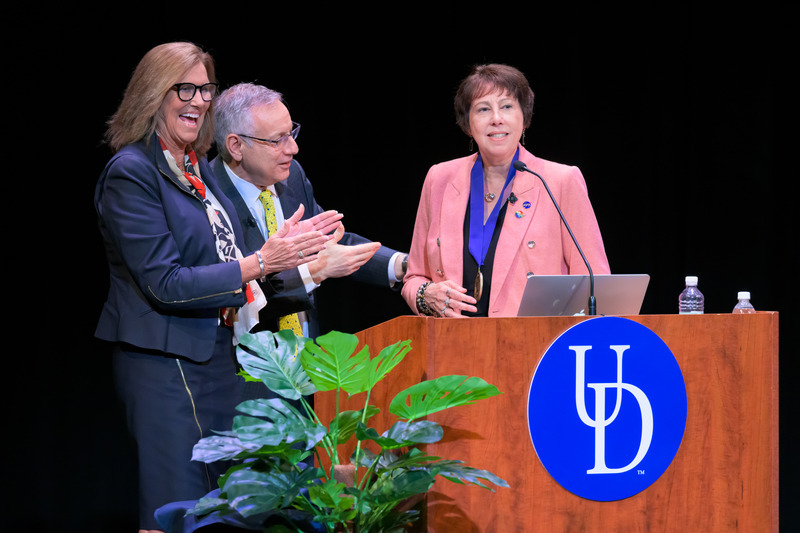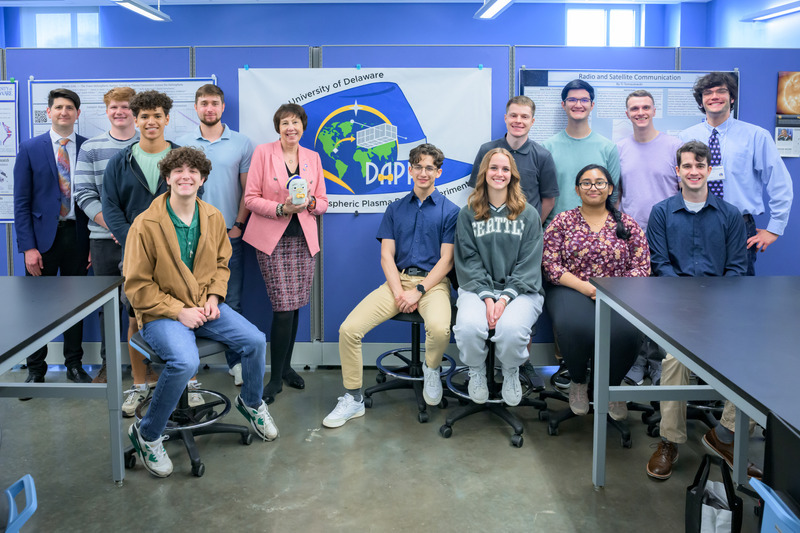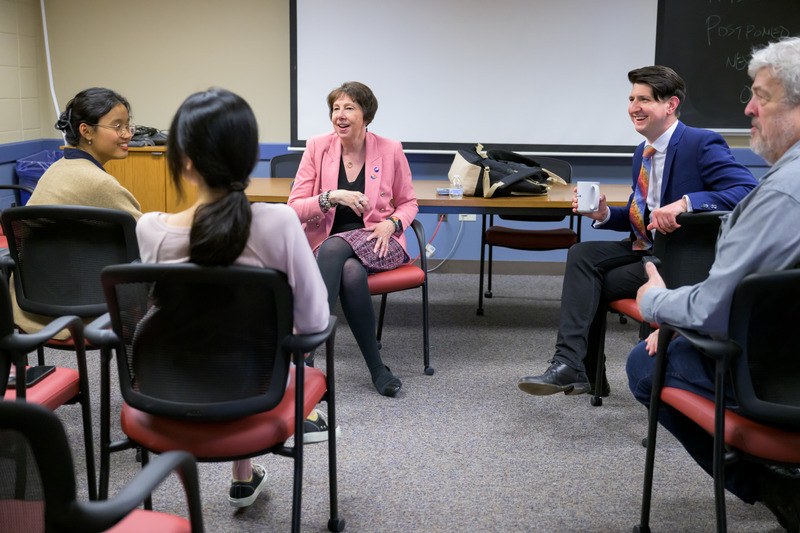


NASA Science Chief invites all to ‘do NASA science’
Photos by Kathy F. Atkinson and Evan Krape April 24, 2024
Nicky Fox shares joy of NASA discoveries and UD research partnerships during April 18 visit
Nicola “Nicky” Fox doesn’t actually remember seeing astronaut Neil Armstrong take humanity’s first walk on the surface of the moon. But she knows she was a witness. Her father had taken her from her crib and propped her up in front of the television to be sure his 8-month-old daughter could see the amazing feat.
Her dad planted a fascination with space in his daughter, and now Fox is chief of NASA’s Science Mission Directorate, with jurisdiction over more than 140 missions exploring just about everything in the known universe — from distant galaxies to the bottom of the sea, from massive stars to subatomic particles.
Her path to leadership in the world’s largest space agency took many turns along the way, including encounters with “imposter syndrome.” But she brought a clear and direct message to the University of Delaware community during a daylong visit Thursday, April 18, inviting everyone to “do NASA science.”
Fox, an expert in space plasma physics, is keen to share the joys of NASA research with everyone — from the UD scientists and engineers working on scores of projects with direct relevance to NASA missions to “citizen scientists” — volunteers who just want to be part of it all.
“Science is for everybody,” she said during a whirlwind tour of UD, which started at the Delaware Space Grant Consortium’s annual symposium and included visits to four labs, presentations by 10 researchers, a public lecture and “fireside chat” with UD President Dennis Assanis, an informal “ask-me-anything” meeting with physics and astronomy students, and finally, the Vernon Lecture, a public event presented by the Mount Cuba Astronomical Observatory at UD’s Clayton Hall.

Along the way, she recognized the work of UD space plasma physicists, astronomers, chemical engineers, microbiologists, materials scientists, data scientists, marine scientists and plant scientists, to name just a few.
And in the midst of this packed agenda, Terri Kelly, chair of UD’s Board of Trustees, recognized Fox with one of the University’s highest honors — the Medal of Distinction. The medal is reserved for those who have made significant humanitarian, cultural, intellectual or scientific contributions to society; achieved noteworthy success in their chosen profession; or given significant service to the community.
“I think she hit the trifecta,” Kelly said.
Indeed, as a researcher, Fox has enabled great advances in our understanding of heliophysics, especially the sun’s atmosphere and its impact on Earth. Perhaps the pinnacle of her scientific achievements was her role as project scientist for the landmark Parker Solar Probe mission, just prior to taking on her new role in NASA administration.
Now, as chief of science for NASA, she oversees a vast span of studies, with a contagious delight in NASA’s work and an engaging knack for communicating science with humor, personal stories and analogies that make the science accessible to broad audiences.
“We need more public scientists like you to help us all engage in these conversations about science and technology and how critical they are to our daily lives and to our planet,” Kelly said.
In his introduction of Fox, Assanis noted the breadth of research she oversees. The Science Mission Directorate includes studies in Earth science, planetary science, biological and physical sciences, heliophysics and astrophysics — all designed to explore the universe and lay the foundation for robotic and human expeditions of the future.
“Think like Star Trek on steroids,” Assanis said, referring to the iconic, long-running television series about life in space and its famous mission statement. “To explore brave new worlds, seek out new life and new civilizations, to boldly go into this expanding, vast universe.”

The invitation to “do NASA science” is real. NASA has dubbed April as “Citizen Science Month” in recognition of the volunteers who have contributed to thousands of scientific discoveries.
“I am blown away by the sheer amount of NASA grants and NASA work going on, either through Space Grant or direct NASA grants,” Fox said. “Soon, for example, we will be bringing samples back from Mars. It’s so difficult. Everybody, help us. How do we do this? These are national challenges, national priorities. So do NASA science!”
Assanis understands the importance of expanding public engagement. It is among the recommendations the President’s Council of Advisors on Science and Technology has made to President Biden, who appointed Assanis to the council in 2022.
Assanis posed multiple questions to Fox during a 30-minute “fireside chat.” The questions were submitted by the public as well as University students and researchers.
Among the issues raised:
The role of biology. Fox, who was director of NASA’s Heliophysics Division before becoming the head of the Science Mission Directorate last year, said she was unaware of the importance of biological research until she became NASA’s science chief and started looking at other areas of research the agency was pursuing. Now she sees its pivotal role, especially for protecting and sustaining the health of astronauts on long-term missions. She mentioned multiple UD projects, including those testing the impact of microgravity on growing food such as lettuce, as well as efforts to bioengineer materials and substances and recycle wastes for use in new ways. Researchers also are looking at how the human body responds to different medications in microgravity and Fox said astronauts will need a personal medication kit, customized for their specific needs.
Building on the moon. Fox said NASA’s Artemis program aims not just to return to the moon for a visit, but to establish a sustained presence there and be able to launch scientific projects there. “We are doing the work on that infrastructure and what it would take to have a sustained presence. We’re looking at byproducts and how they can be turned into something that can be used. You want to use the resources you have there. How do you build a launch site? How do you build a habitat? How do you protect yourself from a space weather event? What can you do with the resources you have rather than taking a Marriott or Hilton up with you?”
Walking on Mars. Fox said students now in kindergarten through high school will be the “Artemis” generation, the generation that will walk on Mars.
International presence. Asked how NASA’s mission compares to those of China, Japan, Russia and other nations, Fox said much has changed since the U.S. put the first human on the moon. “When we went to the moon in the 1960s, we went as a nation,” she said. “When we go now, we go as a global community.”
NASA’s environmental impact. The Earth’s climate and ecology are of keen concern to NASA and Fox said that concern includes the environmental impact of NASA launches. “We study those very carefully,” she said. “There are many different experiments looking at the effects of rocket plumes, both low down and higher up in the atmosphere. It’s something we take very seriously. It’s part of the whole climate we’re looking at. And when you look at stressors on the Earth’s atmosphere, you look at every stressor.”
Evacuating Earth. Asked if we’ll need to evacuate Earth at some point, Fox said, “The more important thing to do is to look after the health of our planet.”
Working for NASA. Asked if international students could work for NASA, Fox sketched out many such scenarios. NASA employees must be citizens, she said, but there are many ways to participate in the work of the world’s largest space agency. “You don’t have to have a NASA badge to work for NASA. You could be here at the University of Delaware, working with any of the research groups that are working on NASA missions building hardware, for example, building the instruments that are going to space. There are ways to be involved in NASA without necessarily being a civil servant.”
NASA’s Vision for Powerful Science
In her public lecture, Fox traced some of the extraordinary research that has emerged since the 2017 launch of the Parker Solar Probe, which in December will come closer to the sun than any other human-made spacecraft. Fox was the project scientist on this mission. UD’s William Matthaeus, Unidel Professor of Physics and Astronomy, helped to lay the scientific foundation for the mission and worked on three of its instrument teams.
She shared extraordinary images produced by the James Webb Space Telescope, launched in 2021, and showed how these images, when combined with those captured by the earlier Hubble Space Telescope, provide nuanced views and complementary data about far-distant galaxies.
She talked about robotic missions that collect samples, such as rocks and dust from asteroids, the ongoing quest to find conditions favorable to life — specifically the presence of carbon and water — and about developing partnerships with commercial companies that provide a variety of services, such as making deliveries to space.
NASA’s Artemis program, with its goal to develop infrastructure on the moon and use it to send crews to Mars and launch spacecraft for even deeper exploration, requires extensive understanding of how such long-term missions would affect the health and wellbeing of astronauts. This highlights the need for more research in biological and physical sciences. It also requires innovative ways of building new structures in space.
Fox also recommended a visit to NASA headquarters in Washington D.C., and a virtual visit to the Earth Information Center’s online headquarters at Earth.gov.
‘No job is beneath you’
Throughout the day, Fox savored encounters with students and took as many of their questions as time allowed.
A frequent request was for her advice on how to get a job at NASA.
“There’s no one path,” she said. “I never set out to be the head of science for NASA. I just enjoy the job I’m doing.”
She urged students to seek out internships, go to lectures, pursue many opportunities to learn and explore the possibilities.
She also urged students and aspiring leaders to embrace the idea that “no job is beneath you.”
“If you’re on a team, something needs to be done,” she said. “The best team leads will do anything.”

She urged students with interest in leadership to take an interest in what everyone on the team is doing.
“If you want to be successful on a team, you need to be knowledgeable,” she said. “Then you can relate to the problem. You can only do that if you put the time in. But you’ll be respected as a leader, because people will know you care about them.
“I identify with an empathic leader,” she said. But there are times, she said, when every leader has to say, “OK, I understand the problem. Now get it done.”
Fox also urged students to talk to those with different roles on the team.
“As a project scientist, the thing that made me efficient and effective was I talked to the engineers,” she said. “Part of it is showing an interest.”
Fox said talking to the engineers about the science objectives of a mission gave them greater understanding of the important role they played in the mission.
She remembered taking Eugene Parker — for whom the Parker Solar Probe was named — into the clean room, where the massive NASA spacecraft was under construction.
“Yes, I said, ‘Parker meet Parker,” she recalled with a laugh.
Fox said Parker got teary with emotion as he saw the powerful instrument his research had inspired.
Engineers in the room asked if they could meet Parker.
“One guy teared up and they had a two-hand shake,” she recalled. “And he said, ‘It’s such an honor to meet you.’ And Parker said, ‘No, it’s an honor to meet you. You’re the people who brought this amazing machine into being. Thank you so much.’
“That meant the world to the engineers,” she said.

Lab tours and research presentations
Fox’s day at UD started with a visit to the annual symposium of the Delaware Space Grant Consortium. The consortium, led by UD’s Matthaeus, includes students and researchers from the University of Delaware, Delaware State University, Delaware Technical and Community College, Wilmington University, Swarthmore University and Villanova University.
Sitting in the front row with Matthaeus and Professor Jim McDonald, deputy director of Delaware Space Grant, she listened to several presentations and interacted with the students before she was whisked away from Perkins Student Center for a trip to UD’s Science Technology and Advanced Research (STAR) Campus.
There, she met with Kelvin Lee, UD’s interim vice president for research, scholarship and innovation and director of the UD-based National Institute for Innovation in Manufacturing Biopharmaceuticals (NIIMBL).

NIIMBL is a Manufacturing USA Institute, sponsored by the U.S. Department of Commerce and based in UD’s Ammon Pinizzotto Biopharmaceutical Innovation Center. Its mission is to solve problems common to manufacturers of biopharmaceuticals and improve the speed and efficiency of producing safe, effective medicines. It pursues that mission through public-private partnerships, with more than 180 members, representing academia, industry, government and non-profit organizations.
Fox also met with Mark Blenner, associate professor of chemical and biomolecular engineering, who has sent yeast strains to the International Space Station. He is working on how to create things astronauts will need if they are working for months on the moon or on Mars. His research focuses on biomanufacturing nutrients, medicines and vitamins, and explores ways to turn waste products into useful materials.
Fox had a working lunch at the nearby FinTech Innovation Hub, where she heard about Qingwu Meng’s research into growing lettuce in space. Meng, assistant professor of controlled-environment horticulture, has sent experiments to the International Space Station to test the effects of different light sources on plant growth.

She also heard about the “rock stars of the universe” — magnetic massive stars — from UD astrophysicist Veronique Petit, who is working to find out where their magnetic fields come from.
And she heard from UD astronomer John Clem, who has launched massive, high-altitude research balloons from Antarctica to measure cosmic-ray electrons and positrons. The January launch of the Anti-Electron Sub-Orbital Payload (AESOP-Lite) mission set a NASA altitude record in Antarctica of 15,551 feet.
“There is no substitute for altitude,” Clem said. “The higher the altitude, the less the atmospheric background.”
Later, she visited the new Delaware Space Observation Center, directed by space plasma physicist Bennett Maruca and based in UD’s Harker Interdisciplinary Science and Engineering (ISE) Lab. Maruca’s students recently learned their satellite mission to study conditions in Earth’s upper atmosphere was accepted for launch by NASA in 2026 as part of its CubeSat Launch Initiative.
At the Center for Composite Materials, Fox talked with Professor Shridhar Yarlagadda about his work on the Hard Upper Torso (HUT) component of NASA’s next-generation spacesuit — the xEMU spacesuit — which is in development for astronauts working in space, outside of the protective environment of a spacecraft or space station.

Finally, she visited the Remote Sensing Lab at Robinson Hall, where she heard from postdoctoral researcher Lingsheng Meng, a member of oceanographer Xiao-Hai Yan’s lab. Yan uses remote sensing to study changes in deep ocean environments. Xinfeng Liang, associate professor and graduate director in the College of Earth, Ocean and Environment, also talked about using NASA data to study changes in the ocean.
Pinki Mondal, assistant professor in the Department of Geography and Spatial Sciences and a resident faculty member of the Data Science Institute, described her use of satellites to detect and track salt patches on coastal farmland. The white patches arise when coastal storms push saltwater onto farmland and they are deadly to crops. Mondal’s team created a “Salt Patch Mapper” application to help track areas where salt patches are appearing and disappearing.
Fox also heard from Tracy DeLiberty, deputy dean of the College of Earth, Ocean and Environment and a member of the Delaware Center for Geographic Education, which works with public school teachers to develop their geospatial science skills, and from Matt Shatley of UD’s Center for Environmental Monitoring and Analysis, who talked about the use of satellite data to track coastal flooding and monitor evacuation routes.
Fox then had dinner with Matthaeus, his wife, Colleen, and Maruca.
“Ben and I were rather exhausted after a long and rewarding day,” Matthaeus said, “but Nicky was still energetic, saying how much fun she had and how much she loves her job. What an amazing scientist and human being. Her visit did so much good for our space-related research at Delaware.”

Contact Us
Have a UDaily story idea?
Contact us at ocm@udel.edu
Members of the press
Contact us at 302-831-NEWS or visit the Media Relations website

